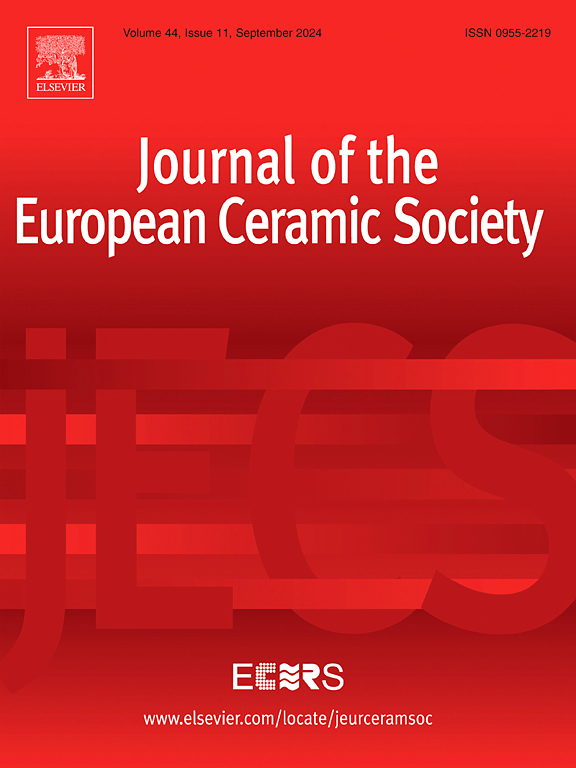CMAS熔体渗透下高熵(Yb0.25Er0.25Ho0.25Y0.25)2SiO5环境屏障涂层的热-机械降解机理
IF 6.2
2区 材料科学
Q1 MATERIALS SCIENCE, CERAMICS
Journal of The European Ceramic Society
Pub Date : 2025-06-06
DOI:10.1016/j.jeurceramsoc.2025.117606
引用次数: 0
摘要
本文研究了高熵(Yb0.25Er0.25Ho0.25Y0.25)2SiO5 (4REMS)环境屏障涂层在CMAS熔体渗透下的热-机械降解机理。研究同时考虑了等温和热循环条件。在等温暴露下,由于形成连续的磷灰石反应层,有效地抑制了熔体的渗透,4REMS涂层表现出优异的耐腐蚀性。Yb3 +、Er3+、Ho3+和Y3+阳离子在CMAS熔体中的协同溶解促进了该致密层的形成。然而,在循环腐蚀测试中,微裂纹的出现破坏了反应层的结构完整性,导致腐蚀物质的渗透速度加快。此外,周期性的温度波动导致溶解-沉淀平衡的动态不稳定,导致磷灰石晶粒的明显形态改变,包括形核增强和粗化。本文章由计算机程序翻译,如有差异,请以英文原文为准。
Thermomechanical degradation mechanisms of high-entropy (Yb0.25Er0.25Ho0.25Y0.25)2SiO5 environmental barrier coatings under CMAS melt infiltration
This study examines the thermomechanical degradation mechanisms of a high-entropy (Yb0.25Er0.25Ho0.25Y0.25)2SiO5 (4REMS) environmental barrier coating under CMAS melt infiltration. The investigation considers both isothermal and thermal cycling conditions. Under isothermal exposure, the 4REMS coating exhibited excellent corrosion resistance due to the formation of a continuous apatite reaction layer that effectively inhibited melt infiltration. The synergistic dissolution of Yb3 + , Er3+, Ho3+ and Y3+ cations in the CMAS melt promoted the formation of this dense layer. However, during cyclic corrosion testing, the emergence of microcracks compromised the structural integrity of the reaction layer, leading to an accelerated penetration rate of corrosive species. Furthermore, periodic temperature fluctuations induced dynamic instabilities in the dissolution-precipitation equilibrium, resulting in pronounced morphological alterations of apatite grains, including enhanced nucleation and coarsening.
求助全文
通过发布文献求助,成功后即可免费获取论文全文。
去求助
来源期刊

Journal of The European Ceramic Society
工程技术-材料科学:硅酸盐
CiteScore
10.70
自引率
12.30%
发文量
863
审稿时长
35 days
期刊介绍:
The Journal of the European Ceramic Society publishes the results of original research and reviews relating to ceramic materials. Papers of either an experimental or theoretical character will be welcomed on a fully international basis. The emphasis is on novel generic science concerning the relationships between processing, microstructure and properties of polycrystalline ceramics consolidated at high temperature. Papers may relate to any of the conventional categories of ceramic: structural, functional, traditional or composite. The central objective is to sustain a high standard of research quality by means of appropriate reviewing procedures.
 求助内容:
求助内容: 应助结果提醒方式:
应助结果提醒方式:


